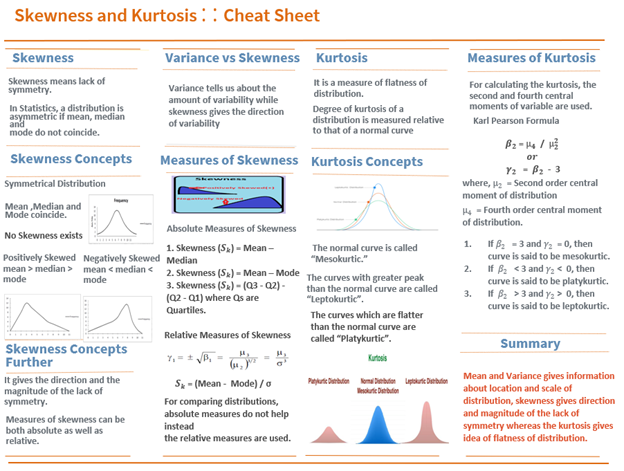
Skewness and Kurtosis — Explanation in detail along with Cheat-sheet…
Last Updated on November 2, 2021 by Editorial Team
Author(s): Supriya Ghosh
Machine Learning
Skewness and Kurtosis — Explanation in detail along with Cheat-sheet…

Before we start with the Skewness and Kurtosis, let me explain in brief about Moments since we will need moments for in and out understanding of Skewness and Kurtosis.
Defining Moments
In Statistics, moments are defined as measures that explain certain characteristics of the distribution.
Generally, in any frequency distribution, four moments are obtained which are known as first-order (µ1), second-order (µ2), third-order (µ3), and fourth-order(µ4) moments respectively.
The first moment describes the information about the mean, the second moment describes the information of variance, the third moment of skewness, and the fourth moment of kurtosis of a frequency distribution respectively.
Mean and Variance gives information about the location and scale of distribution, skewness gives the direction and the magnitude of the lack of symmetry whereas kurtosis gives the idea of flatness of distribution.
Concept of Skewness
Skewness means lack of symmetry.
In mathematics, a figure is called symmetric if there exists a point within it through which if a perpendicular is drawn on the X-axis, it divides the figure into two congruent parts i.e., mirror images of each other.
In Statistics, a distribution is called symmetric if mean, median, and mode coincide. Otherwise, the distribution becomes asymmetric.
If the right tail is longer, we get a positively skewed distribution for which mean > median > mode while
if the left tail is longer, we get a negatively skewed distribution for which mean < median < mode.
The below figure depicts the Skewness.
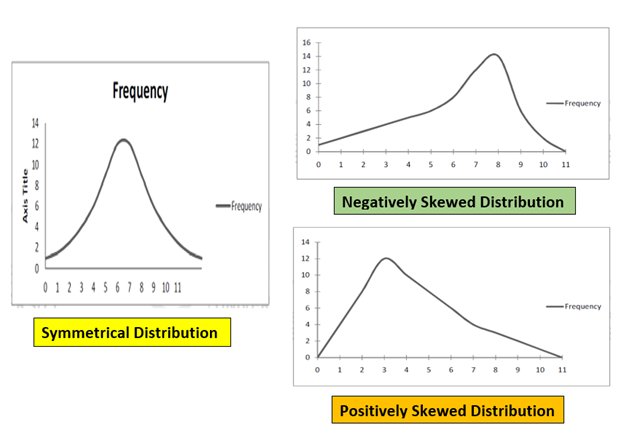
Difference between Variance and Skewness
There are two important points of difference between variance and skewness.
1. Variance tells us about the amount of variability while skewness gives the direction of variability.
2. In business and economics, measures of variation have larger practical applications than measures of skewness. However, in medical and life sciences measures of skewness have larger practical applications than the variance.
Various measures of Skewness
Measures of skewness help us to know to what degree and in which direction (positive or negative) the distribution has a deviation from symmetry. Although positive or negative skewness can be detected graphically depending on whether the right tailor the left tail is longer, we don’t get an idea of the magnitude. Besides, borderline cases between symmetry and asymmetry become difficult to detect graphically. Hence some statistical measures are required to find the magnitude of lack of symmetry.
A good measure of skewness should possess the following criteria:
1. It should be unit-free so that the shapes of different distributions, as far as symmetry is concerned, can be compared.
2. If the distribution is symmetric, the value of the measure should be zero. Similarly, the measure should give positive or negative values if the distribution has positive or negative skewness respectively and
3. As we move from extreme negative skewness to extreme positive skewness, the value of the measure should vary accordingly.
Measures of skewness can be both absolute as well as relative. Since in a symmetrical distribution mean, median and mode are identical. The more the man moves away from the mode, the larger the asymmetry or skewness.
An absolute measure of skewness cannot be used for purposes of comparison because the same amount of skewness has different meanings in distribution with small variation and in distribution with large variation.
Absolute Measures of Skewness
Following are the absolute measures of skewness:

For comparing distributions, absolute measures do not help instead the relative measures are used which are called the coefficient of skewness. The coefficient of skewness is pure numbers independent of units of measurements.
Relative Measures of Skewness
In order to make a relevant comparison between the skewness of two or more distributions, we have to eliminate the distributing influence of variation. Such elimination can be done by dividing the absolute skewness by standard deviation.
The following are the important methods of measuring relative skewness:
β and γ Coefficient of Skewness
Karl Pearson defined the following β and γ coefficients of skewness,
based upon the second and third central moments:

It is used as a measure of skewness.
For asymmetrical distribution, β1 shall be zero. β1 as a measure of skewness does not tell about the direction of skewness, i.e., positive, or negative. Because µ3 being the sum of cubes of the deviations from the mean may be positive or negative but µ3 square is always positive.
Also, µ2 being the variance is always positive. Hence, β1 would be always positive. This drawback is removed if we calculate Karl Pearson’s Gamma coefficient γ1 which is the square root of β1 i. e.

Then the sign of skewness would depend upon the value of µ3 whether it is positive or negative. It is advisable to use γ1 as a measure of skewness.
Karl Pearson’s Coefficient of Skewness
This method is most frequently used for measuring skewness. The formula for measuring the coefficient of skewness is given by

Important points about Skewness
1. If the value of the mean, median, and mode are the same in any distribution, then the skewness does not exist in that distribution. Larger the difference in these values, the larger the skewness.
2. If sum of the frequencies is equal on both sides of the mode, then skewness does not exist.
3. If the distance of the first quartile and third quartile is the same as the median, then skewness does not exist. Similarly, if deciles (first and ninth) and percentiles (first and ninety-nine) are at equal distance from the median. then there is no asymmetry.
4. If the sums of positive and negative deviations obtained from mean, median, or mode are equal then there is no asymmetry and
5. If a graph of data becomes a normal curve and when it is folded at the middle and one part overlaps fully on the other one, then there is no asymmetry.
Concept of Kurtosis
If we have the knowledge of the measures of central tendency, dispersion, and skewness, even then we cannot get a complete idea of distribution. In addition to these measures, we need to know another measure to get the complete idea about the shape of the distribution which can be studied with the help of Kurtosis. Prof. Karl Pearson has called it the “Convexity of a Curve”.
Kurtosis gives a measure of the flatness of distribution.
The degree of kurtosis of a distribution is measured relative to that of a normal curve. The curves with a greater peak than the normal curve are called “Leptokurtic”. The curves which are flatter than the normal curve are called “Platykurtic”. The normal curve is called “Mesokurtic.” The below figure describes the three different curves.
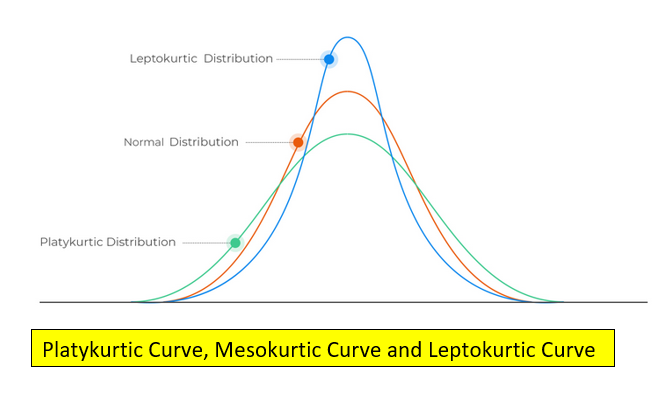
Measures of Kurtosis
Karl Pearson’s Measures of Kurtosis
For calculating the kurtosis, the second and fourth central moments of the variable are used. For this, the following formula is given by Karl Pearson is used:
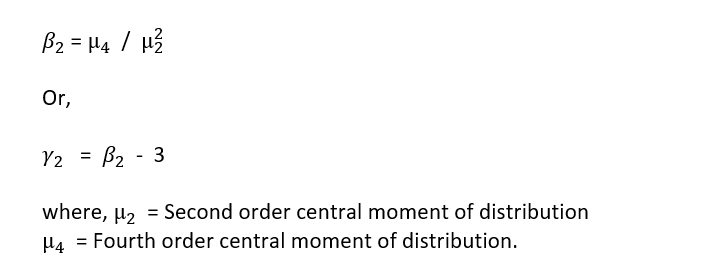
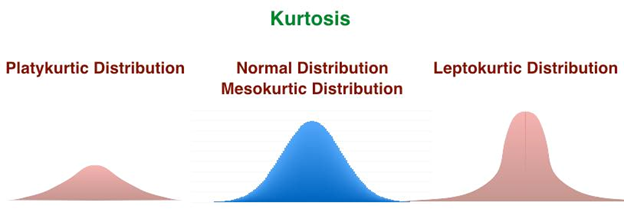

Summary —
Let me summarize Skewness and Kurtosis as below.
1. Skewness gives the direction and the magnitude of the lack of symmetry whereas Kurtosis gives the idea of flatness of distribution.
2. In Symmetric distribution with no Skewness, mean, median and mode coincide.
3. Positively skewed distribution has mean > median > mode while a negatively skewed distribution has mean < median < mode.
4. Measures of skewness can be both absolute well as relative, but an absolute measure of skewness cannot be used for purposes of comparison of distributions.
5. Degree of kurtosis of a distribution is measured relative to that of a normal curve. The curves with a greater peak than the normal curve are called “Leptokurtic”. The curves which are flatter than the normal curve are called “Platykurtic”. The normal curve is called “Mesokurtic.”
6. In business and economics, measures of variation have larger practical applications than measures of skewness. However, in medical and life sciences measures of skewness have larger practical applications than the variance.
Hope this article helps to capture the crux of Skewness and Kurtosis.
Thanks for reading!!!
You can follow me on medium as well as
LinkedIn: Supriya Ghosh
And Twitter: @isupriyaghosh
Skewness and Kurtosis — Explanation in detail along with Cheat-sheet… was originally published in Towards AI on Medium, where people are continuing the conversation by highlighting and responding to this story.
Published via Towards AI
Take our 90+ lesson From Beginner to Advanced LLM Developer Certification: From choosing a project to deploying a working product this is the most comprehensive and practical LLM course out there!
Towards AI has published Building LLMs for Production—our 470+ page guide to mastering LLMs with practical projects and expert insights!

Discover Your Dream AI Career at Towards AI Jobs
Towards AI has built a jobs board tailored specifically to Machine Learning and Data Science Jobs and Skills. Our software searches for live AI jobs each hour, labels and categorises them and makes them easily searchable. Explore over 40,000 live jobs today with Towards AI Jobs!
Note: Content contains the views of the contributing authors and not Towards AI.
















Comments are closed.